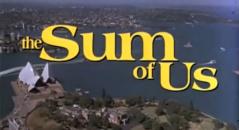 7015616656562297264.jpg
7015616656562297264.jpg
 7015616656562297264.jpg
7015616656562297264.jpg
Set in Sydney, The Sum of Us explores the relationship between Harry, a charming, beer-drinking, down-to-earth widower, and Jeff, his gay son. Harry is the caring 'mate' whose open-mindedness borders on being annoying. Jeff unsuccessfully searches for love with the unwanted guidance of his father.
Writing Disability in Australia
| 0 | 1 |
|---|---|
| Type of disability | Paralysis and wheelchair use after a stroke. |
| Type of character | Primary. |
| Point of view | Third person. |
'A concept of visibility frames much scholarship and public writing on LGBTQ+ representation in film and television, and underpins diversity reporting and inclusivity measurement. Although visibility is often depicted as a social good, there is a growing critical interest in asking if there are different kinds of visibility, and how these might be differentially valued. This paper reports insights gained from interviews with Australian stakeholders involved in the production of screen entertainment with LGBTQ+ content. The study found that stakeholders are motivated by to create texts that make LGBTQ+ stories and characters visible. The range of approaches to visibility was, however, nuanced and diverse: some understood any LGBTQ+ representation as valuable, while others discussed visibility in contexts of character depth, anti-stereotyping, and visibility tempered by concepts of human dignity. Although visibility is perceived diversely, it remains a significant lens by which creative artists involved in LGBTQ+ texts understand their work.' (Publication abstract)
'Despite an often‐repeated cliché that gender and sexually diverse characters are relatively absent from film and television, Australian screen production has a very rich history of representing sexual and gender diversity: greater than nineteen wide‐release films since 1993, including internationally recognized films such as Priscilla, Queen of the Desert (1994), The Sum of Us (1994), Head On (1998), and The Monkey’s Mask (2000), portray gender and sexual diversity. Nine Australian films with LGBTQ, gender, and sexually diverse themes were released between 2013 and 2018, indicating an entrenchment of LGBTQ representation on Australian screens. Characters in major Australian television dramas and soap operas, such as Home and Away and Neighbours, have increased in regularity and complexity over the past two decades. Sexual stories, including narratives of minority sexual lives, have never, of course, been repressed or invisible, but according to Ken Plummer, they have long been central to contemporary Western culture (4). Stories representing gender and sexually diverse subjects depicting identity struggles and articulating minority health outcomes are a major and ongoing part of Australian creative production. What is significant in cultural analysis is not questions of visibility or invisibility but how the continuities and disruptions of depictions of gender and sexual minorities play a significant, pedagogical role in social participation, social harmony, acceptance, individual health and wellbeing, and community belonging (Cover, Queer Youth Suicide; Emergent Identities).' (Introduction)
'This essay looks at the critical reception of Australian queer cinema demonstrating the difference in reviews of queer Australian films. The Adventures of Priscilla, Queen of the Desert (Elliot, Stephan. 1994. The Adventures of Priscilla, Queen of the Desert. Sydney: Roadshow Distribution) and The Sum of Us (Dowling, Kevin, and Geoff Burton. 1994. The Sum of Us. Sydney: Southern Star) will be compared to films that came later in the 1990s, notably Love and Other Catastrophes (Croghan, Emma-Kate. 1996. Love and Other Catastrophes. Sydney: Fox Searchlight), The Well (Lang, Samantha. 1997. The Well. Sydney: Southern Star) and Head On (Kokkinos, Ana. 1998. Head On. Melbourne: Umbrella Entertainment). These later films managed to generate buzz on the queer film festival circuit as well as at general international film festivals. Their queerness attracts international LGBTQ audiences while, secondly, genre-related elements have the potential to attract a wider cinephile audience. I will utilise paratextual elements, particularly reviews during their film festival and theatrical runs, to demonstrate how they cross-over to wider audiences. In investigating their framing and reception, these films increasingly engage audiences through their genre signifiers. This essay demonstrates that the discourse around Australian queer cinema has matured to offer multi-faceted perspectives.' (Publication abstract)